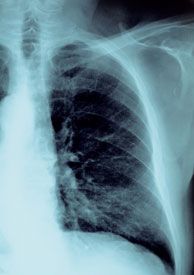Article
ASTRO Issues Guidelines for Palliative Lung Cancer Care
Author(s):
ASTRO has for the first time issued its own extensive guidelines for the use of palliative thoracic radiotherapy in patients with metastatic lung cancer

Amid wide variation in treatment practices, the American Society for Radiation Oncology (ASTRO) has for the first time issued its own extensive guidelines for the use of palliative thoracic radiotherapy in patients with metastatic lung cancer.
Three significant findings concerning regimens for external beam radiation therapy (EBRT), endobronchial brachytherapy (EBB) in routine settings, and concurrent use of chemotherapy and EBRT have emerged from the nearly 2-year review of clinical trial evidence.
The review was spurred by a desire to harness knowledge gained from the past several decades’ worth of studies, according to George Rodrigues, MD, a radiation oncologist and clinician scientist at the London Health Sciences Centre in London, Ontario, Canada, who co-chaired the multidisciplinary ASTRO task force that developed the guidelines.
“Collectively, tens of thousands of patients have been put into these clinical trials,” Rodrigues said in an OncLive interview on Friday. “There was a need for a pretty straightforward guideline…a resource to go to and simply look at the data.”
Benjamin Movsas, MD, chairman of radiation oncology at the Henry Ford Health System in Detroit, Michigan, who also co-chaired the panel, said prior surveys “suggest the treatment methods were all over the map.
“This is very significant because it’s really critical to have a guideline that is based upon evidence,” he said. “Radiation does really significantly help these patients. It’s been shown over and over again. This is really all about how to optimize that.”
The guidelines involve treatment approaches to palliative care for patients whose cancer has spread and who are experiencing symptoms such as coughing, shortness of breath, bronchial obstruction, and chest pain.
Specifically, the task force determined:
- Various regimens for thoracic EBRT are effective in alleviating symptoms, with doses and number of treatments dependent upon the patient’s performance status and experience with adverse effects. The guidelines include a chart that summarizes the findings of 14 different studies.
- The use of EBB in routine initial palliative management of lung cancer is not recommended because the evidence does not support it. There are patients, however, who may benefit from EBB if they would have failed previous EBRT and are now experiencing recurrent bronchial obstruction.
- The administration of chemotherapy concurrently with radiation therapy does not provide an added benefit in relieving patients’ symptoms. However, patients may benefit if chemotherapy is integrated into the treatment plan before or after radiation, or during a break in the radiation cycle.

Rodrigues said dose fractionation with EBRT was the biggest question looming before the panel. “It becomes this sort of balancing act,” he said. “It really depends on what the goals of treatment are, and, in terms of the performance status of the patient, how much the patient can tolerate.”
He said previous guidelines were developed through international bodies, but that ASTRO decided to tackle the matters itself as part of a broader effort to develop clinical practice standards for North American specialists.

Movsas said the take-home message for community radiation oncologists is that there is evidence to guide complex treatment decisions. The guidelines, he said, are “a good resource and will help so people can feel more comfortable with their decisions and recommendations.”
Rodrigues G, Videtic G, Sur R, et al. Palliative thoracic radiotherapy in lung cancer: an American Society for Radiation Oncology evidence-based clinical practice guideline. Practical Radiat Oncol. 2011;1(2):60-71.
Available at http://www.practicalradonc.org/article/S1879-8500(11)00091-9/fulltext








